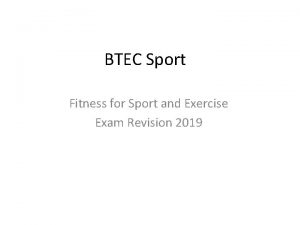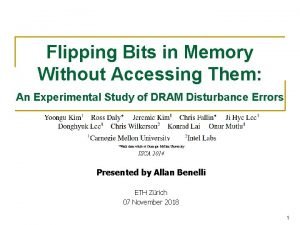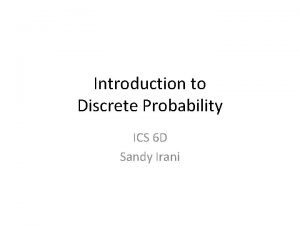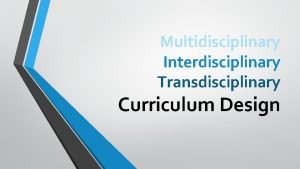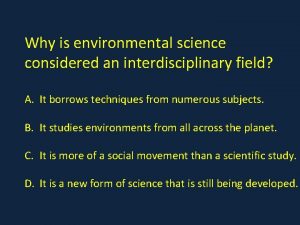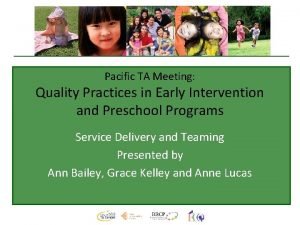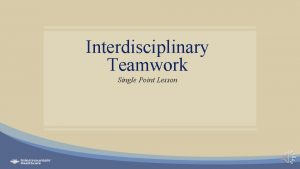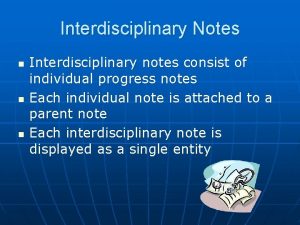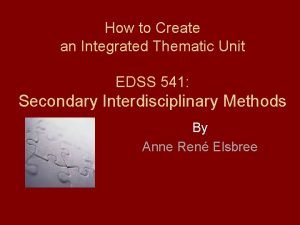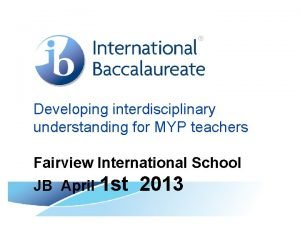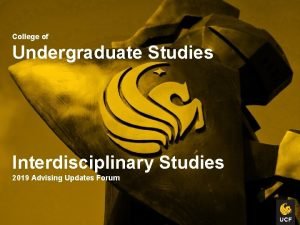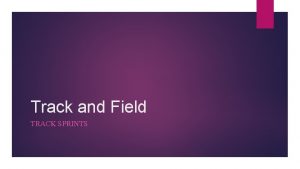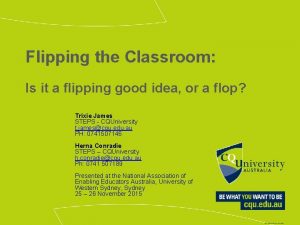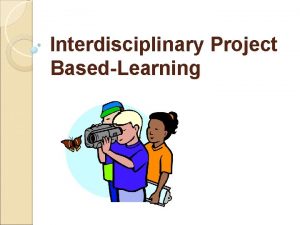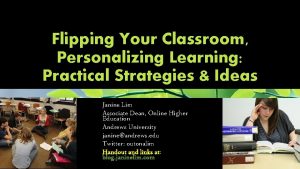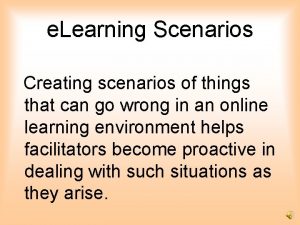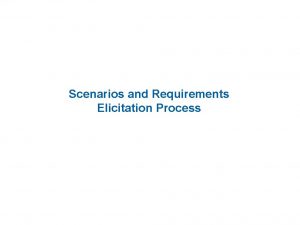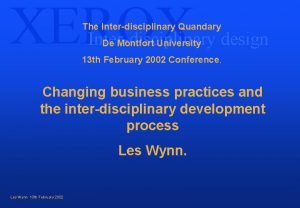Flipping sprints and scenarios Strategies for interdisciplinary learning












- Slides: 12

Flipping, sprints and scenarios: Strategies for interdisciplinary learning at the computing/life science and medicine interfaces Andy Brass, Angela Davies, Andrew Devereau, Simon Ramsden School of Computer Science , FLS, FMHS, NHS

Motivation (1) • The linkage between the humour in Walter Scott and high energy particle physics • Learning to love the Archers • Why do I need to read new things three times to begin to make sense of them?

Motivation (2) • How do we learn new things? – To learn something, teach it – Doing supports learning – Good problems help good learning • Good students can learn more from each other than they do from their teachers • Learning as collaboration • Getting the right feedback at the right time

Caveats • Based on teaching at PGT/CPD levels • Class sizes < 50 • I dislike “teaching” and examinations – Always believed that our job at the university was to provide students with tools and a framework for taking control of their own learning

Strategy First time through Second time through Third time through Framing Application Group work on the scenario Reading on line material (cast list) Lectures (relationships and linkages) Assessment • Staged as mini “learning sprints” • Very clearning objectives for each sprint • Structured and regular formative feedback • Summative feedback on groupwork Learning taxonomy levels Assessed scenario Typically individual work based on the group work, or a related new scenario

Bloom world Scenarios and groupwork Self study and lectures

Typical teaching material: NHS course to train new clinical bioinformaticians • We train the tutors: • On each of the 5 days of the course they will be receiving lectures in the morning and then will work on a specific part of the scenario in the afternoon. The afternoon sessions will be divided into two tasks. These short tasks are all related and will combine together to provide a framework to allow them to successfully complete the group exercise (scenario analysis). Each subtask will have specific learning objectives associated with it as listed in this document. It is your job as a tutor to check that the students are working towards these objectives. If all is going well, then you can let the students get on with things. However, if you feel that they are exploring blind alleys, getting confused, misinterpreting the task, then please nudge them on track with a few well-chosen question (“do you feel this approach is appropriate. . ”, “have you perhaps thought of considering. . . ? ” ). At the end of each section you need to be comfortable that your group has covered the learning objectives of each session. At the end of each task every group will be expected to provide a short report on what they have achieved. As tutors we will provide formative feedback on these reports after all the groups have contributed. If any groups have missed some of their learning objective despite a tutor’s best efforts, this can be highlighted at this point in the afternoon. As a tutor you are also expected observe your group carefully so as to be able to complete a final summative assessment of the group performance. The marking scheme used for this assessment is described in section 2. • • • Always run a practice session – supports both students and tutors in the learning style Be explicit about the style of teaching and why it is used

ILOs made explicit Category of outcome Introduction to Clinical Bioinformatics and Genomics Knowledge and understanding These ILOs assessed in the report 1. Discuss the governance and ethical frameworks in place within the NHS and how they apply to bioinformatics. 2. Discuss and justify the importance of standards, best practice guidelines and standard operating procedures: how they are … 6. Discuss the role of polymorphisms in Mendelian and complex disorders and give examples of polymorphisms involved in genetic disease. Intellectual skills These ILOs tested in the report Practical skills These ILOs tested in the group work 1. 2. 3. 4. 5. Critically analyse scientific and clinical data Present scientific and clinical data appropriately Formulate a critical argument Evaluate scientific and clinical literature Apply the knowledge of clinical bioinformatics to address specific clinical problems 1. 2. Present information clearly in the form of verbal and written reports. Communicate complex ideas and arguments in a clear and concise and effective manner. Work effectively as an individual or part of a team. Use conventional and electronic resources to collect, select and organise complex scientific information …. Perform the recording of building or version numbers of resources used on a given date, including those of linked data sources, and understand the clinical relevance of this data. 3. 4. 5. 6. Transferable skills and 1. Present complex ideas in simple terms in both oral and written formats. personal qualities 2. Consistently operate within sphere of personal competence and level of authority. These ILOs tested in 3. Manage personal workload and objectives to achieve quality of care. the group work and the 4. Actively seek accurate and validated information from all available sources. final report 5. . .

Relevant scenarios from clinical practice • Scenario: A 30 year old woman presents at clinic with bilateral breast cancer and with a with strong family history of breast and ovarian cancer. The Consultant Clinical Geneticist has forwarded a blood sample to the lab for BRCA 1 and BRCA 2 testing. • Test: The coding regions and consensus splice sites of BRCA 1 and BRCA 2 are sequenced using Sanger dideoxy sequencing. • Results: Heterozygous NM_000059. 3(BRCA 2): c. 9976 A>T p. Lys 3326 Ter

Tutor notes for the scenario • Evidence: In the literature you will find evidence that this nonsense change does not segregate with disease in some breast/ovarian cancer families. In fact it is not regarded as a risk factor for breast/ovarian cancer. However there is an increased prevalence in patients with this change with familial pancreatic cancer suggesting that this polymorphism is deleterious and contributes to pancreatic cancer risk Wu et al. , Cancer Res, 2005 65: 417 -426. • Interpretation: This nonsense change is not responsible for the breast cancer in this woman. We would highlight the increased risk of other cancers in the laboratory report, however the relative risk is quite low and the clinician may not choose to tell the patient this information. • Notes: In the UK, a woman's lifetime risk of developing breast cancer is 10% by the time she is 80 years old. Having a fault in one of the breast cancer genes ( BRCA 1 and BRCA 2) raises the risk of developing breast cancer to between 50% and 85% in their lifetime. Therefore a woman in this situation has a raised a priori risk of having a BRCA 1 or BRCA 2 mutation. If we could identify the causative mutation in a family such this would enable presymptomatic testing of relatives. • Despite the fact that this is a nonsense change it is located in the most 3’ exon of BRCA 2. Typically a nonsense change in a gene would be regarded as pathogenic without the need for a bioinformatic analysis. However caution must be applied to nonsense changes in the last exon (or more exactly within 50 bp of the last intron exon boundary – including the penultimate exon) as these premature stops will not result in a message that is subject to nonsense mediated decay. Routine bioinformatic tools will not be of any use in this regard – you need to read the literature and understand disease mutational mechanisms to arrive at the right conclusion. • Therefore in this instance this nonsense change cannot be used to predict breast/ovarian risk to family members.

Staged work (sprints) • Day 1 of the scenario • Each group has been given a scenario. On day 1 of the scenario a patient has been referred for genetic testing. At this stage there is a suspicion as to why there might be a concern, but no results have been obtained. The aim of this session is for the trainees to develop good skill sets for retrieving information around the genetics of the disease of interest, to develop standard operating protocols (SOPS) that capture best practice in the area , and finally to retrieve key facts from the retrieved literature discussing genotype/phenotype relationships for the disease of interest. • Part 1: Locating the information • • Key learning objectives: strategies for effective and clinically relevant information retrieval from scientific and other resources. To explore what a scientific paper is as an artefact, how is it constructed (useful information could be in methods or results sections, some data could be in supplementary information, the refereeing process, the importance of citations). To understand where scientific literature is stored (journals/online). To gain an understanding of tools for retrieving papers – in particular systems such as scholar google for tracking citations. To develop effective online-search strategies and the importance of capturing the process in an SOP. To explore non-refereed sources – patient blogs, generic internet, curated internet resources (Omim). To gain an understanding of tools for managing references. Short report: Each group to give a short informal presentation on the strategy (SOP) they are using to find the relevant papers and information. Formative feedback from tutors • Part 2: Extracting clinically relevant meaning: • • Key learning objectives: The production of concise, informative and authoritative statements based on a review of literature To be able to extract key facts from the literature – what is it that the paper is claiming, is it believable, how would you know? To provide evidence of authority (use of citation counts, journal impact factors. To be able to illustrate good referencing to provide audit. Short report: Each group to put together a short document highlighting the key facts (bullet points are acceptable, but must have good citations and evidence for source authority) Formative feedback from tutors

Conclusions • Pros: – – – – Excellent student satisfaction scores Good feedback to tutors as to progress Students appreciate the formative feedback Develops a strong learning “community” Clear evidence that learning outcomes have been completed We have learnt new things Staged learning supports students better than a less structured approach • (FOFO+) – Supports blended strategies very well – Supports DL well • Cons: – – – – It needs the right sort of teaching space. Is it scaleable? – does it scale in standard lecture theatres? Could it work UG? Training costs Preparation costs – good scenarios are hard to design Does not suit all types of teaching Requires attendance, what do you do about student illness or resits…
 Btec sport test
Btec sport test Flipping bits in memory without accessing them
Flipping bits in memory without accessing them The probability of sandy flipping
The probability of sandy flipping Transdisciplinary vs interdisciplinary
Transdisciplinary vs interdisciplinary Why is oceanography an interdisciplinary science
Why is oceanography an interdisciplinary science Cuadro comparativo entre e-learning b-learning y m-learning
Cuadro comparativo entre e-learning b-learning y m-learning A science is considered interdisciplinary when weegy
A science is considered interdisciplinary when weegy Multidisciplinary vs interdisciplinary
Multidisciplinary vs interdisciplinary Single point lesson
Single point lesson Interdisciplinary notes
Interdisciplinary notes Components in designing integrated thematic units
Components in designing integrated thematic units What is interdisciplinary
What is interdisciplinary Interdisciplinary studies ucf
Interdisciplinary studies ucf
